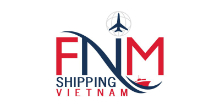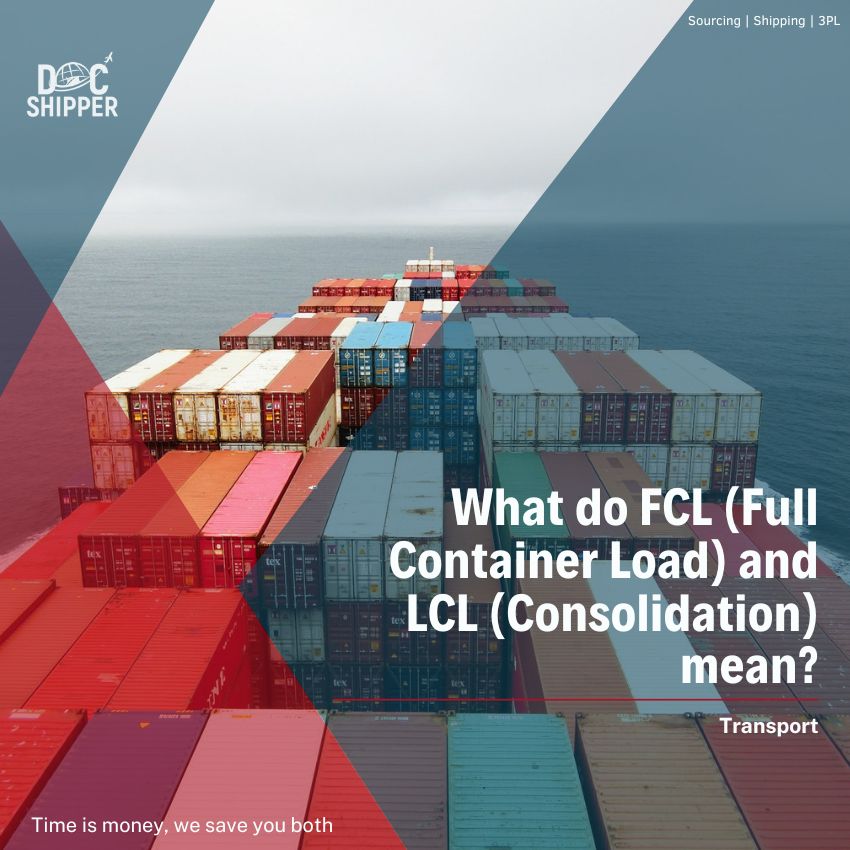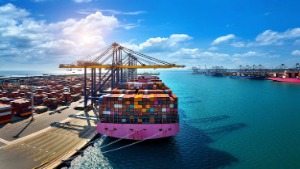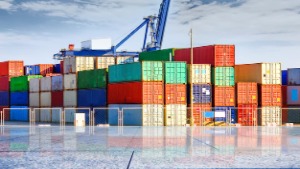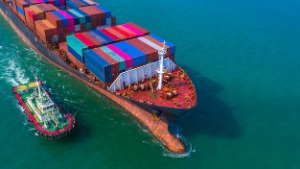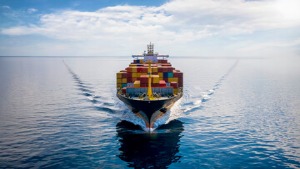Today, importers and exporters use various acronyms. This makes it difficult to understand certain terms when a sector is not in our field, especially when these terms sound alike. This has been particularly true for LCL and FCL shipments. That's why we are going to show you in this article the differences between an LCL or FCL shipment, so that you can better understand and choose the one that suits you best.
DocShipper | Logistics, Procurement and Quality Control
Welcome to the DocShipper group's English division, your import/export assistant! Utilize a trustworthy partner to help you with all aspects of the process, including B2C distribution, international transit, quality control, and compliance. Because communication is essential, we attempt to discuss in the most relevant manner for you! Contact us!
Summary
LCL Shipping: Definition
The word "LCL" is an acronym that stands for "less than a container load". LCL shipment is a term that describes a type of shipment, in this case it corresponds to a maritime shipment that is too small to completely fill a container. As for the transport that takes place on land, the shipment is called LTL (less-than-truckload/less-than-load).
In case an exporter does not have enough goods to fill a container, he can use a carrier or a forwarder to store the goods with other goods, which is a good way to save money and not to spend too much. Below is some more information about this type of shipping:
- This type of shipment will be charged by the cubic footage of your goods. This is due to the fact that the goods are grouped together. Sometimes they are also called "groupage shipments".
- With LCL freight, the goods are sorted by the forwarders at the destination or transfer point. The goods are then sent to the various consignees or ports involved.
LCL export: The forms
It is true that you collaborate with carriers and forwarders. However, it is your responsibility to ensure the proper documentation is included with your shipments. Although your forwarder does represent you, you are the expert on your company. The freight forwarder is primarily in charge of the items' transportation, but he has absolutely nothing to do with your export documentation or the business' compliance. Because the form you are about to provide is not under the obligation of the sea freight and the forwarder, please fill it out as accurately and correctly as you can.
DocShipper Tip : DocShipper can take care of all the administrative and customs procedures for international transport. Please complete this form, and one of our experts will contact you within 24 hours.
Documents required for your export shipment
We will provide a complete list of all required paperwork to properly prepare your LCL export shipment.
Commercial invoice : This invoice needs to be carefully completed in three copies.
Packing list : A crucial list since providing the carrier and the eventual destination with information about your shipment is quite helpful. Along with this information, it logically includes the packing list and specifics about the markings on the outside of the boxes.
Certificate of origin : Certainly, some countries do not require only the declaration of origin on the commercial invoice, but some customs structures have the possibility to request a certificate of origin. Other countries have a free trade agreement, so remember to check if this is the case for your country, because if it is, you will have to send a form specific to this agreement.
A letter of instruction from the sender is still the best way to retain a written record. It enables you to offer information about your business as well as the phone numbers of the individuals to contact if you need further details about a cargo, documentation of an export, or knowledge of the recipient of your export paperwork.
Sender Instruction Letter : A letter of instruction from the sender is still the best way to retain a written record. It enables you to offer information about your business as well as the phone numbers of the individuals to contact if you need further details about a cargo, documentation of an export, or knowledge of the recipient of your export paperwork.
Bills of lading : You will require a bill of lading or numerous bills of lading to accompany your export.
Other documents, as needed : A dangerous products form, bank draft, free sale certificate, insurance certificates, permits or other licenses, cargo receipts, etc. may fall under this category.
DocShipper Tip : DocShipper can take care of all the administrative and customs procedures for international transport. Please complete this form, and one of our experts will contact you within 24 hours.
Benefits of LCL Shipping
LCL shipping has a number of benefits and is an excellent way for smaller forwarders to break into the market.
More accessible because cheaper
Shared container shipping is an excellent approach to lessen the load on your supply chain. For an FCL shipment, you won't pay for a complete container; instead, you'll split the price of a container with the other customers who will be utilizing it. You can reduce the cost of your shipments in this way. Although it is not required in this instance, most shippers wait until the container is completely filled before dispatching shipments, as we have discovered.
A more flexible schedule
Unfortunately, things don't always go as planned because of time constraints. Since we are not restricted to a long-term shipping plan that requires shipments that totally fill a container, this is not a constraint with LCL shipping.
Focus on your business
The bottom line is that while shipping is important to your supply chain, most firms don't prioritize it as their main emphasis on a daily basis. While you are concentrating on closing sales, your shipment has to run in the background. Utilize a freight forwarder to plan your timeline for LCL shipment internationally.
DocShipper Tip : Do you need freight services to ship your products abroad? Please complete our freight quote form, and one of our experts will contact you within 24 hours.
LCL shipping: the steps
Step 1: Booking a shipment
Of course, it makes sense that scheduling a shipment would be the initial action. The forwarder will reserve a container through an "LCL consolidator" once you explain that you do not have enough products to fill a container.
Make sure you transmit all pertinent information to the cargo during this phase, and the forwarder will come up with the best option for you. Generally speaking, this data relates to your shipment's weight, size, quantity of items, etc. Your forwarder will be able to advise you on the best options based on this information, especially after taking notice of the size of your products.
Your freight forwarder can compare the costs of your shipment between FCL and LCL based on the size of your shipment to determine which method is the most economical.
Once the freight forwarder has received all the information, they can schedule your shipment. To prevent delays brought on by the busy season, reserve your space as soon as feasible (most often starts in August until October). Additionally, this will help you keep your supply chain on schedule and save money.
DocShipper Note: DocShipper offers a home storage and delivery service. This article contains all the information you require regarding this service. Get in touch with us for further details!
Step 2: Preparation of the merchandise
The second step is to get your shipment ready for shipping. Depending on the freight, this process may take some time. As a result, we recommend that you begin preparing it as soon as possible, especially if the goods require special packaging.
Certain types of products, such as lithium batteries, are subject to several laws that necessitate particular packaging. This is something you will need to consider when planning.
Step 3: Consolidate
The second step is to get your shipment ready for shipping. Depending on the freight, this process may take some time. As a result, we recommend that you begin preparing it as soon as possible, especially if the goods require special packaging.
Certain types of products, such as lithium batteries, are subject to several laws that necessitate particular packaging. This is something you will need to consider when planning.
Step 4: the “drayage”
If your products have already been consolidated at the port of departure, the container will need to be transported to the port of departure. “Drayage" is a logistics term that refers to items that are moved over a short distance. It is one of the most significant phases because your goods will only arrive at their destination for export in this manner.
Step 5: Shipping
The following step will be to ship your cargo out of your nation and hence abroad. The shipping can be made directly or via a transshipment point, which is a port where all items are unloaded and then shipped abroad. If your shipment is concerned with the first, it will reach at its destination without stopping, but if it is concerned with the second, it will stop in transshipment ports before arriving at its destination.
Step 6: Unbundling
When your goods arrive at the port of entry, it will be unloaded and transported to a container freight station, where it will be separated. The container will be emptied, and the cargo will be split and shipped to their respective destinations. This procedure typically takes 3 to 6 days.
Step 7: Collection or delivery
Once your items have been unbundled, they are ready for your shipping company to pick up and, based on the shipping conditions, are frequently delivered to your house.
At the time of delivery, the recipient of the goods is typically required to sign a receipt confirming that they have done so.
DocShipper Tip : DocShipper offers assistance with international transportation. Whether the shipment is carried out by Sea freight or Air freight. Contact us to receive a free shipping quote in less than 24h.
When is LCL shipping the best option?
This method of shipment is the best option in the following situations:
You can’t fill the entire container
One of the most obvious reasons to select LCL shipping over FCL shipping is the inability to fill the whole container. It makes no sense to pay for a complete container if only half of it is used. However, depending on where you intend to deliver your consignment, request that your freight forwarder compare the two possibilities.
Small goods
LCL shipping is favorable if your package is less than 13 cubic meters in volume because the cost is often calculated based on weight and volume. Be mindful of the benefits of FCL shipping, which we shall cover in more detail later in this post.
Abundance of products
It's likely that you have so many items that one container won't suffice. In this instance, shipping via LCL is a great choice. You can fill one container and then use an LCL shipment to fill the remaining container, knowing that using another FCL container is not always a wise option.
DocShipper Note : Do you require assistance in determining the appropriate cargo for you? Our specialists will contact you when you fill out our shipping form and within 24 hours.
FCL Shipping: Definition
After we've looked at LCL shipping, let's have a look at FCL shipping. It is prudent to select a cost-effective and secure choice while minimizing costs throughout your supply chain. Full Container Load (FCL) shipping is a beneficial alternative in many situations, particularly when delivering a significant volume of merchandise. FCL shipping includes transporting products in a "full" container. The container is only utilized for one whole cargo. You will not be sharing the container with any other items; it will be all yours. However, this also implies that you are responsible for the entire shipment's expense.
Benefits of FCL Shipping
The FCL expedition has numerous advantages; here are a few that we believe are important:
The cost
Unexpectedly, it costs less to ship large quantities in an FCL container than an LCL. The fact that the LCL cargo is charged per cubic meter, whereas the FCL is charged per container can be used to explain this. The FCL has a very strong price-performance ratio beyond this level and is more efficient. The LCL is best for modest volumes, i.e., less than 10 cubic meters.

An LCL's port fees could run as high as $125 per CBM. The port fees would rise to $3,500 for an FCL shipment of the same volume and to $2,700 for an LCL shipment.
Damage Control
Your items won't be combined with any other commodities because they are the only ones in the container, thus you won't sustain much harm. Additionally, the commodities require less handling because they are gathered together. It's possible that when you receive your shipment, your container won't have ever been opened or handled. Please be aware, nevertheless, that irrespective of your shipping, customs costs will be applied.
Efficiency
Because you won't need to deliver numerous little packages in various shipments, using FCL is considerably more efficient than using LCL. You won't be required to pay repeated customs fees as a result. Since everything is shipped together in this instance, your goods are handled better, processed more cheaply, and handled more quickly.
FCL Shipping: The Steps
Step 1: Booking a Shipment
Of course, booking your shipping through FCL comes first. Your freight forwarder can handle the freight booking, but you must be sure to provide him with all the specific details necessary to make the booking. Therefore, provide as much information as you can (weight, volume, sizes, etc.) to help your freight forwarder book a cargo and confirm your requests as efficiently as possible. The freight forwarder will schedule a shipment for you as soon as he gets all the necessary information. Like LCL, make sure to make reservations outside the busy times to prevent delays and additional fees.
Step 2: Preparing Goods for Shipment
The preparation of your items for shipping is the following stage. Depending on the type of the items, this could take some time. We advise you to get started as soon as possible and get guidance on whether your products need specific packaging.
For instance, there are a lot of rules governing lithium battery packaging. This must be taken into consideration while creating your schedule.
Step 3: Drayage
Once your items have been packaged and are ready to go, the entire container will be "transported" to the port where they will be exported.
A service that specializes in moving cargo over short distances—in this case, to the port of export—is referred to in logistics as "drayage."
Step 4: Cargo in Transit
Your FCL cargo will be traveling on the proper vessel when it reaches the port.
Similar to the LCL, your cargo can be delivered either directly to its final location or to a port for transshipment. In the second scenario, it will make multiple port stops on route to its final destination. Depending on the situation, each case has a benefit.
Step 5: Pickup or Delivery
This final phase is comparable to the LCL in that your goods will be unloaded and delivered to the destination place in accordance with the incoterm when it reaches the port. The receipt must be signed by the person who receives the items.
DocShipper Tip : We provide total supply chain coverage with our 3PL service . We handle worldwide logistics, quality assurance, and compliance. Get in touch with us for further details!
FCL Shipping: When is it the best option?
When you have enough cargo to fill a single container, this form of cargo is unquestionably the better choice and is significantly more efficient. This is the ideal choice if your cargo can fit inside one container.
The goods are large enough
Using FCL shipping is still a wise choice if your package is substantial and more than 15 cubic meters? If you have a huge cargo, consider using this method of shipment because it is in this situation much more effective and profitable.
Regular shipments
If your goods can fill an entire container, and you are used to sending goods, this kind of shipment remains the best way. However, if you want to ship a small amount of goods at the last moment, then LCL is a better solution.
In conclusion - Which is better between LCL and FCL?
Consider your company's objectives when choosing between FCL and LCL shipment to make the best decision. Then, you will be much better able to make decisions based on your needs. If you are still unsure after that, contact our DocShipper experts, who will give you advice on what will work best for your individual requirements.
FAQ | Ocean Freight: LCL (Less than Container Load) and FCL (Full Container Load) [FULL GUIDE]
Less-than-Truckload (LTL) transport is the practice of getting your products in a few shipments or small batches. This is equivalent to a portion of a truckload
Two or more nations agreeing to their economic exchanges in order to facilitate their circulation is known as a free trade agreement.
FCL and LCL each have benefits and drawbacks. Due to the need to move a lesser amount of cargo by sea without having to pay for the entire container space, FCL gave rise to the LCL industry. The buyer will have a better grasp of the best way to utilize based on the circumstance and volume of the shipment if they are aware of the distinctions between the two ocean freight arrangements.
When items from many shippers are delivered to the same consignee, LCL/FCL shipping techniques are employed. The items are then placed in a single container in a grouping. What is LTL transport?
What is a free trade agreement?
What is the best between FCL and LCL?
What do LCL and FCL have in common?
DocShipper info: Did you like this article? You may also like the following:
Adivce FNM :We help you with the entire sourcing process so don't hesitate to contact us if you have any questions !
- Having trouble finding the appropriate product? Enjoy our sourcing services, we directly find the right suppliers for you!
- You don't trust your supplier? Ask our experts to do quality control to guarantee the condition of your goods!
- Do you need help with the logistics? Our international freight department supports you with door to door services!
- You don't want to handle distribution? Our 3PL department will handle the storage, order fulfillment, and last-mile delivery!
DocShipper | Your dedicated freight forwarder in Vietnam !
Due to our attractive pricing, many customers trust our services and we thanks them. Stop overpaying the services and save money with our tailored package matching will all type of shipment, from small volume to full container, let us find the best and cost-effective solution.
Communication is important, which is why we strive to discuss in the most suitable way for you!
